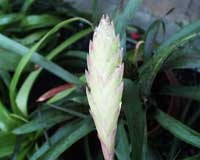The red spider lily, known as Lycoris radiata, is a flower steeped in tragic legends and mysterious tales. This flower is often associated with stories of sorrow, separation, and despair. For fans of classic Chinese films, the beauty and significance of this flower evoke strong emotions.
Unknown Facts About the Red Spider Lily
Perhaps due to its mystique, many wonder about the special spiritual significance of the red spider lily.
The red spider lily is a flower associated with tragic legends and mysterious tales.
Understanding the Red Spider Lily
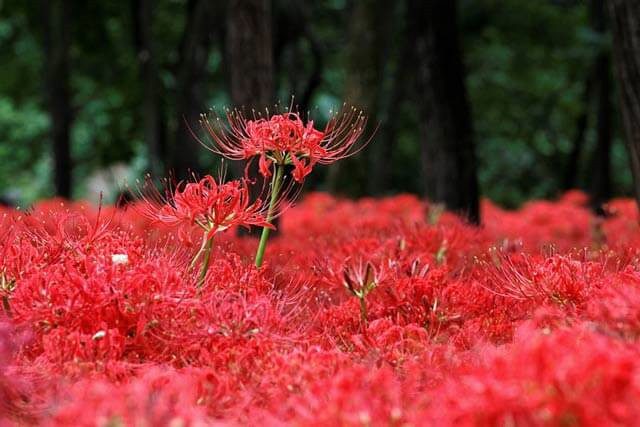
The red spider lily is real and found in many places around the world.
The scientific name for the red spider lily is Lycoris radiata, and it is known by many names, including Higanbana, Manjusaka, and Red Spider Lily. The red spider lily is grown from bulbs and blooms after about three months.
In reality, the red spider lily is genuine and can be found scattered in many parts of the world. This flower is a member of the Amaryllidaceae family and is native to China, later being found in Japan and the United States in 1854.
A notable feature of the red spider lily is its eye-catching clusters of blossoms. It is a perennial herbaceous plant, growing to a height of 40 to 100 cm. The red spider lily typically grows wild along rice paddies, roadsides, hillsides, and especially in cemeteries. It comes in a variety of colors including red, white, purple, and yellow.
One unique aspect is that the red spider lily blooms precisely on schedule, three days before and after the Spring Equinox is called Spring Higan, and three days before and after the Autumn Equinox is called Autumn Higan. The flowers grow naturally and are cultivated from bulbs. The bulbs of the red spider lily are toxic as they contain lycorine, a toxic alkaloid that can damage the nervous system.
Meaning of the Red Spider Lily
Legends of the Red Spider Lily
According to legend, the red spider lily is the only flower that grows along the path to the afterlife. Before souls cross the Nai He Bridge, which spans the River of Forgetfulness, they deposit all their memories into the red spider lily. Whether filled with unbearable sorrow or deep love, the red spider lily embraces all these memories.
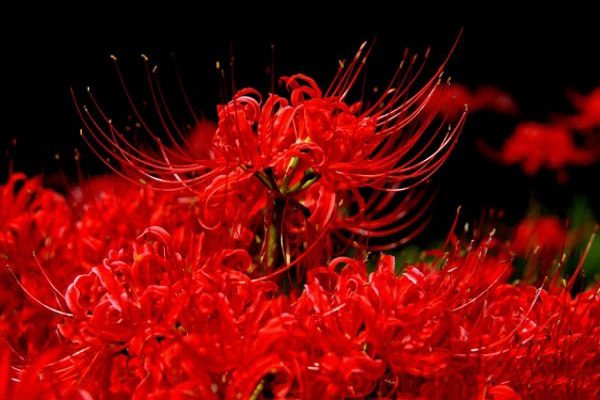
If you see the flowers bloom, you won’t see the leaves, and if you see the leaves, you certainly won’t see the red spider lily flowers.
Cultural Significance of the Red Spider Lily
In different countries, the red spider lily holds various meanings:
- In Japan, it symbolizes painful memories.
- In Korea, it signifies longing for one another.
- In China, it represents pure beauty, separation, suffering, and the beauty of death.
Overall, this flower symbolizes separation and despair. The red spider lily embodies “separation, sorrow, misfortune, and the beauty of death,” yet many people interpret its meaning as “painful memories.”
Conversely, some believe that the red spider lily does not solely represent misfortune and separation, as seen in the perspectives of Japan, Korea, and China. Many countries regard it as a symbol of good luck and purity. Therefore, the red spider lily is commonly used in funerals and during cemetery visits. Notably, these flowers are also cultivated for decoration in temples and villas. When planted in large areas, they create a stunning effect resembling a “river of red spider lilies,” often featured in legendary films.
A striking characteristic of the red spider lily is that if you see the flowers bloom, you won’t see the leaves, and if you see the leaves, you certainly won’t see the red spider lily flowers. This is why the flower embodies meanings of separation, distance, and sorrow.
Spiritual Meaning of the Red Spider Lily
Interestingly, the red spider lily blooms at very specific times. It blooms three days before and after the Spring Equinox is referred to as Spring Higan, and three days before and after the Autumn Equinox is called Autumn Higan. The red spider lily blooms precisely during Autumn Higan, marking a significant time.
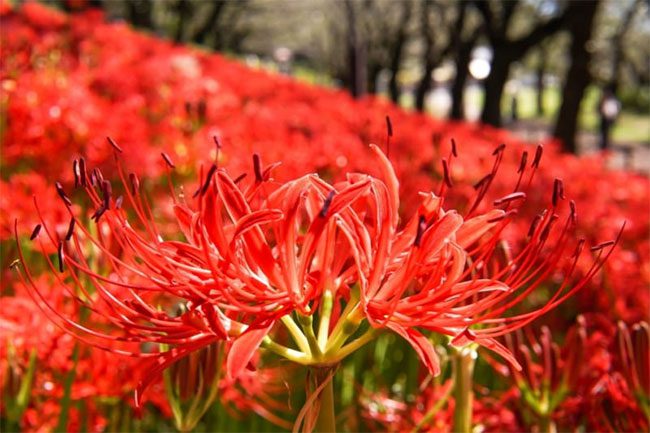
The red spider lily blooms precisely on schedule.
The explanation for the two equinoxes is that these are the two days of the year when the sun is directly overhead at the equator. The red spider lily blooms in conjunction with the Autumn Equinox. This is also the time described in Buddhist teachings, where during the seven days of autumn, the living can enter the realm of the dead to meet their ancestors.
In folklore, it is believed that the red spider lily serves as a gateway to the world of the deceased. Some claim that during these days, the living can meet with spirits, as the red spider lily is a dwelling place for souls.
Many people believe that planting the red spider lily around one’s home may bring misfortune and adversity. However, this belief is misguided. In Vietnamese cultural beliefs, planting the red spider lily signifies a connection between the living and their ancestors, allowing them to visit and bless their descendants with peace and health.
From a feng shui perspective, planting the red spider lily at the entrance of a house is believed to bring good fortune in both work and future life.
Where Does the Red Spider Lily Grow in Vietnam?
The red spider lily has been cultivated in many parts of the world. In recent years, this flower has been introduced to Vietnam and has gained popularity due to its beauty and profound significance.
In Vietnam, if you wish to witness the beauty of the red spider lily firsthand, you can visit Da Lat. This city is considered the only place in Vietnam where this special flower grows. The cold climate and hilly terrain are ideal for its development. Thus, the red spider lily in Da Lat has gradually become a unique symbol of this region, alongside hundreds of other flowers that enhance the beauty of the highland city.
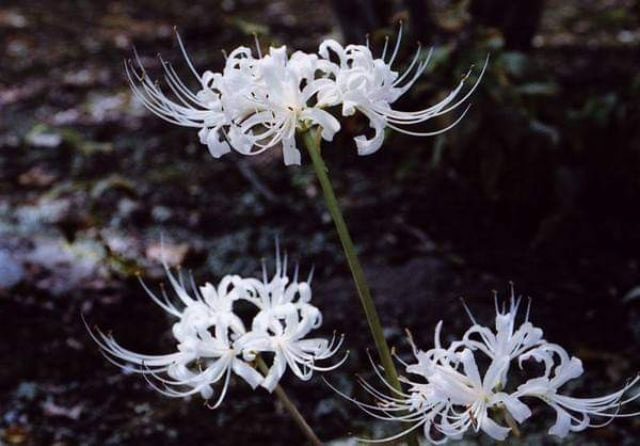
In Buddhism, the red spider lily is also referred to as a flower symbolizing the Heavenly Realm.
In Buddhism, the red spider lily is mentioned as a flower symbolizing the Heavenly Realm. Therefore, many believe that seeing a red spider lily helps one avoid negative karma in life. So why not give it a try?
How Toxic is the Red Spider Lily?
Research indicates that the bulbs of the red spider lily contain high levels of lycorine and galantamine, which can inhibit the nervous system. This is the reason why many people accidentally ingest the bulbs of this flower, leading to poisoning, nerve paralysis, and even death without clear cause.
However, medical science is still researching the medicinal properties of the red spider lily bulbs, successfully testing them for treating various ailments. They are known for their anti-inflammatory, pain-relieving, sedative, and anti-cancer properties. The scent of the red spider lily is similar to garlic, making it effective in repelling many insects and rodents. Additionally, it is used in medicine to treat swelling, edema, and joint pain.
Thus, from a certain perspective, the toxicity of this flower can also benefit medicine and human health instead of causing harm.








































